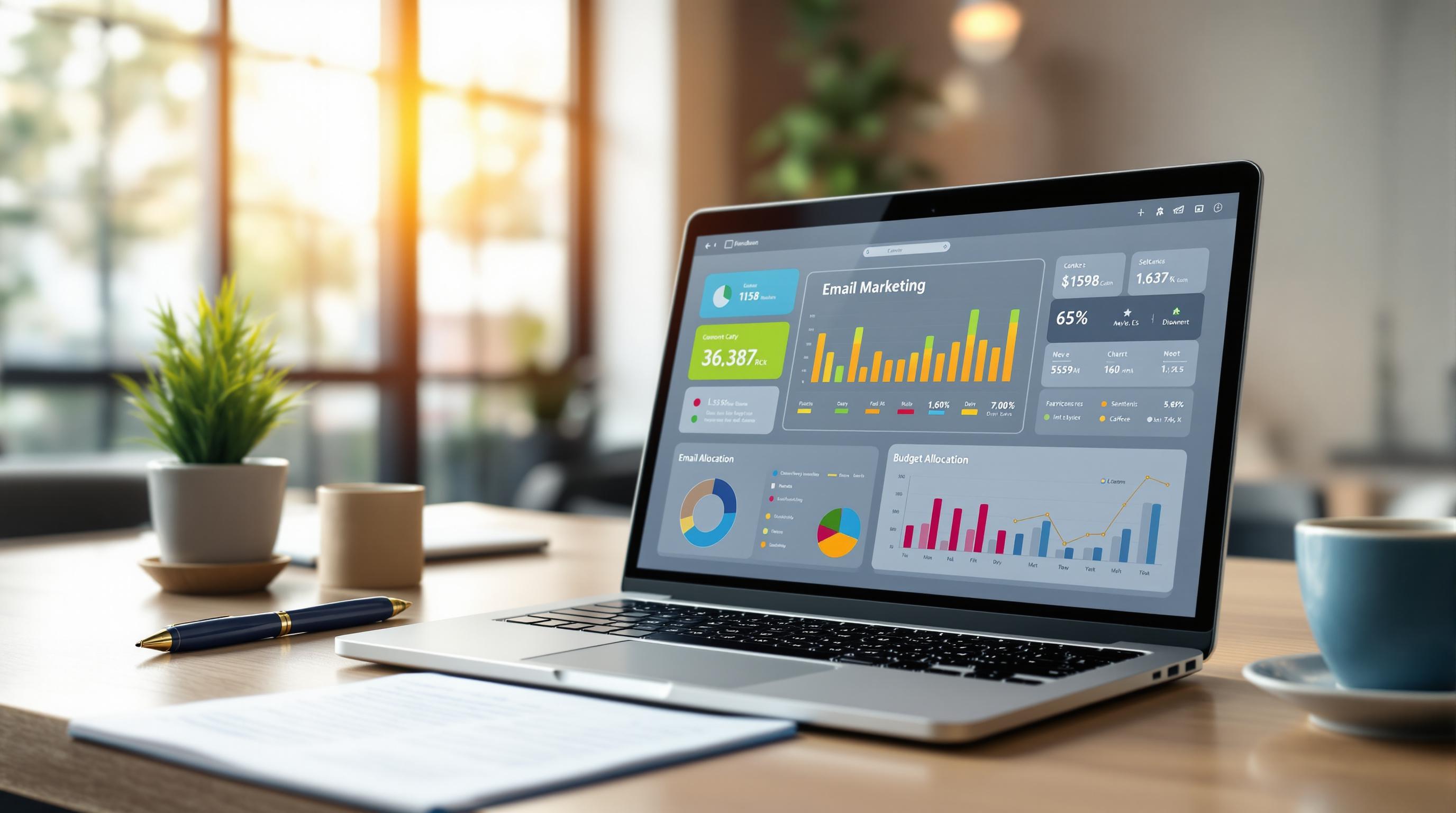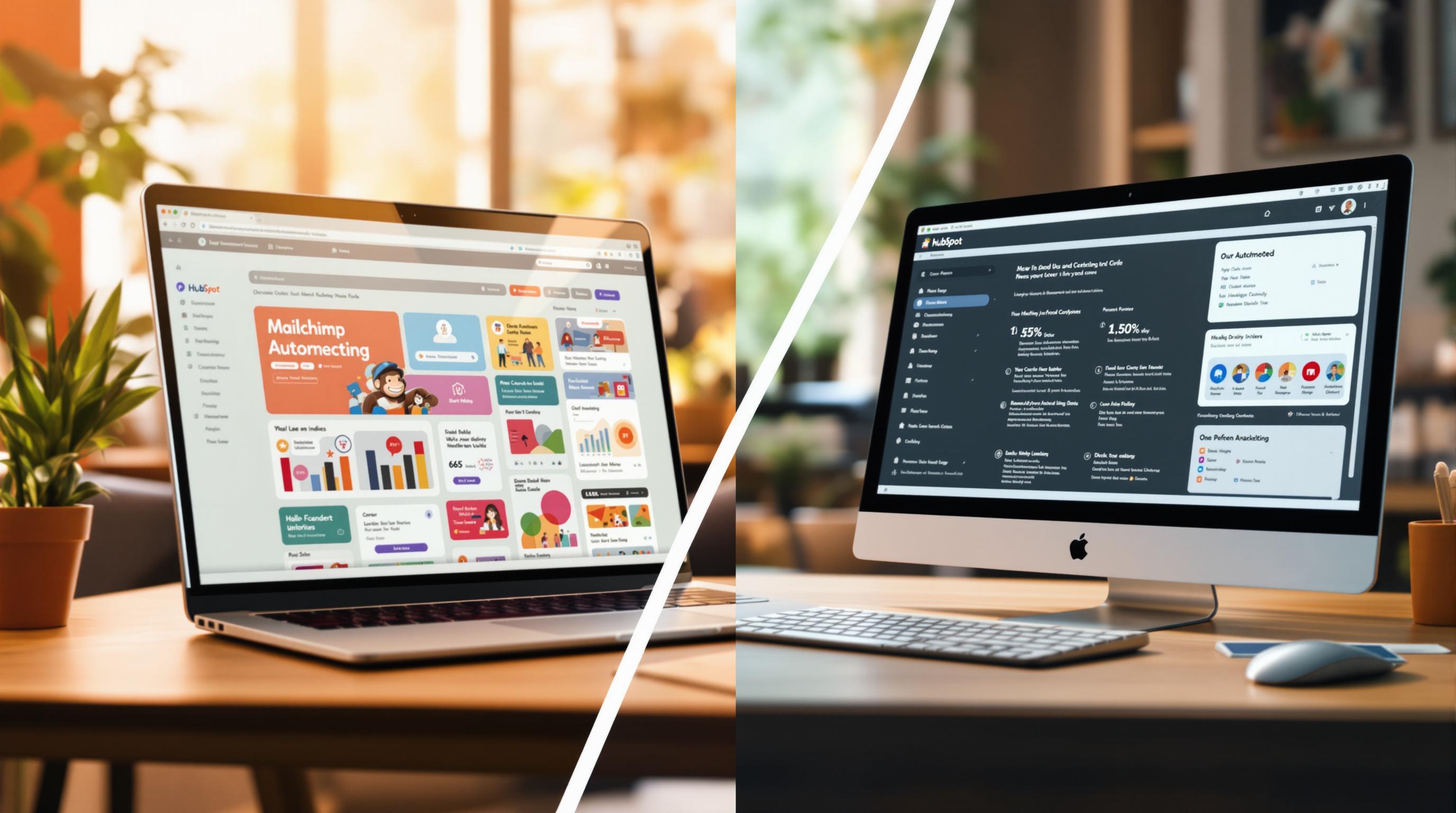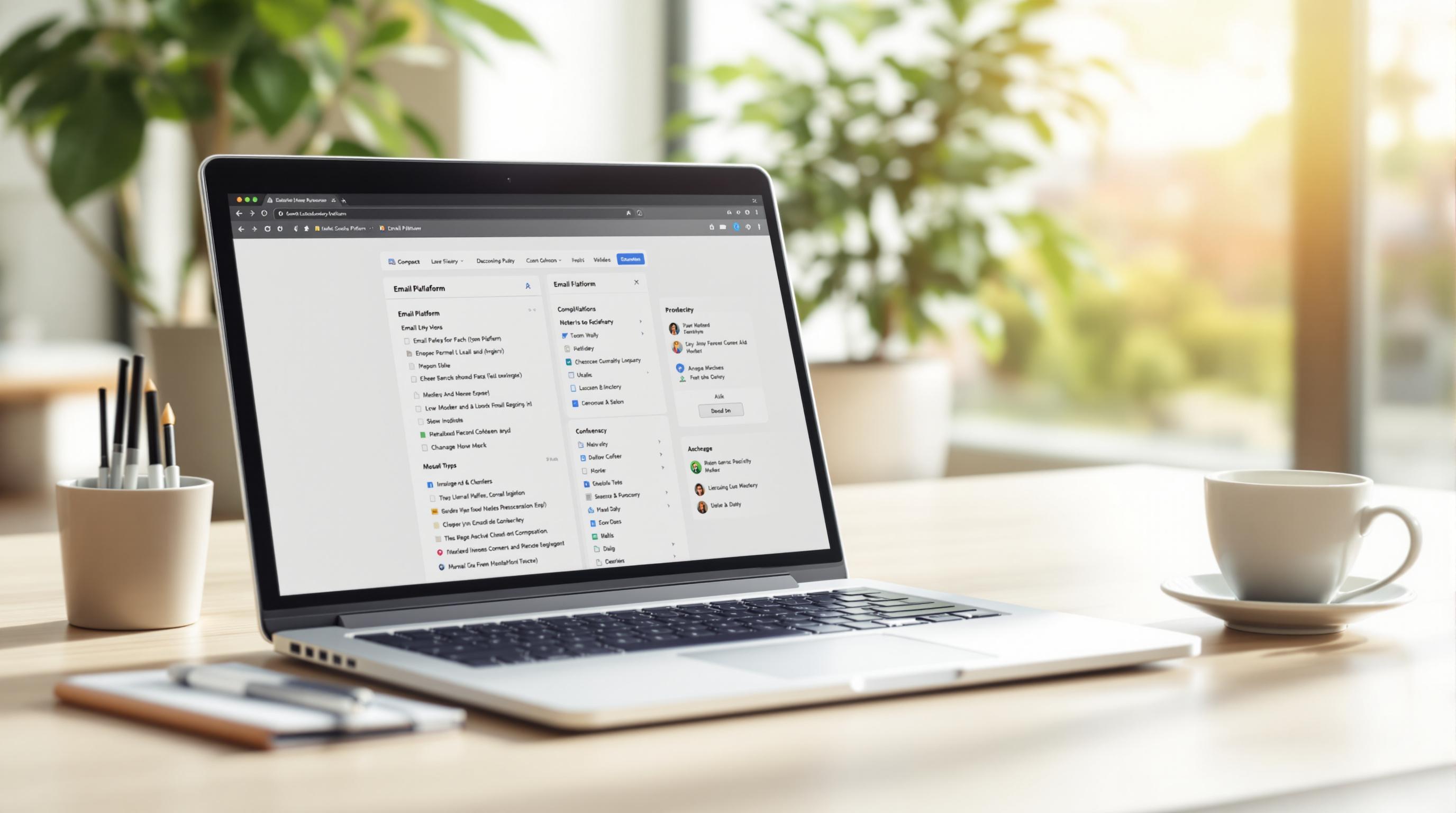B2B and B2C businesses need different tools to manage customer relationships because their goals, audiences, and sales processes are very different. Here’s a quick breakdown:
- B2B Tools: Focus on long-term relationships, managing complex sales cycles, and working with multiple decision-makers. Features include CRM integration, lead nurturing, and account-based marketing.
- B2C Tools: Aim for fast conversions and high-volume engagement with individual consumers. Features include real-time personalization, dynamic product recommendations, and cart recovery emails.
Quick Comparison
| Aspect | B2B Automation | B2C Automation |
|---|---|---|
| Sales Cycle | Long-term, complex | Short-term, transactional |
| Decision Process | Multiple stakeholders | Individual consumers |
| Data Focus | CRM systems, account-level data | User behavior, purchase trends |
| Key Features | Lead scoring, account-based marketing | Cart recovery, dynamic content |
| Goal | Build relationships, nurture leads | Drive immediate conversions |
Key takeaway: Use B2B tools for managing complex sales processes and building long-term relationships. Use B2C tools for quick, personalized engagement that drives purchases. Keep reading to learn how to choose the right tool for your business.
Differences in B2B and B2C Lifecycle Automation
Audience and Sales Journey Comparison
B2B automation tools are designed to manage lengthy, complex sales cycles that involve multiple stakeholders. In contrast, B2C tools focus on individual consumers and shorter, transactional journeys. For example, HubSpot's enterprise automation platform is built to handle detailed approval workflows that require input from several decision-makers.
| Aspect | B2B Audience | B2C Audience |
|---|---|---|
| Data Requirements | Business-level data analysis | Individual behavior, purchase history |
| Communication Style | Professional, solution-focused | Personal, emotion-driven |
| Purchase Process | Formal evaluation and approval | Quick, often impulse-driven |
| Purchase Value | High-value, complex contracts | Lower-value, frequent transactions |
Marketing and Engagement Strategy Differences
B2B tools often emphasize account-based marketing and nurturing leads over time. They rely on tailored content and personalized solutions to build strong, long-term relationships. Platforms like Salesforce's B2B solution excel in this area, offering features like advanced lead scoring and tracking engagement across multiple touchpoints.
Meanwhile, B2C tools prioritize fast conversions. Automation platforms like Omnisend use features such as dynamic product recommendations, cart recovery emails, and real-time personalization (e.g., adjusting email content based on live user actions) to drive immediate results.
A key difference lies in how these tools handle data. B2B platforms focus on account-level analytics and managing intricate sales processes, while B2C tools analyze individual customer behavior and transactional trends.
Recognizing these distinctions helps businesses select automation tools that align with their audience and objectives. The features and capabilities of B2B and B2C tools are shaped by these strategic differences.
Features of B2B and B2C Automation Tools
B2B Tool Features
B2B automation tools are built to manage intricate sales cycles and decision-making processes involving multiple stakeholders. According to Nucleus Research, marketing automation can increase sales productivity by 14.5% while reducing marketing overhead by 12.2% [2].
Some standout features include advanced lead scoring and tools that extract business intelligence from email data. For example, Pardot's analytics suite offers detailed account-based marketing solutions, enabling businesses to monitor engagement across various decision-makers within target organizations [3].
B2C Tool Features
B2C automation tools focus on immediate engagement and driving fast consumer actions. A great example is GetResponse MAX, which uses AI-driven product recommendations and integrates with over 100 tools to enhance personalization [4].
Dell demonstrated the power of these tools by leveraging behavioral analysis to improve click-through rates by 70% and boost conversions by 300%, using personalized ads based on browsing history [1].
Feature Comparison Table
Here's a breakdown of the key differences between B2B and B2C automation tools:
| Feature Category | B2B Tools | B2C Tools |
|---|---|---|
| Lead Management | Multi-touch attribution, Pipeline tracking | Behavioral scoring, Purchase history analysis |
| Customer Engagement | Account-based marketing, Professional content delivery | Real-time personalization, Social proof integration |
| Analytics Focus | Company-level insights, Deal progression tracking | Individual behavior analysis, Purchase pattern recognition |
| Integration Capabilities | CRM systems, LinkedIn Sales Navigator | E-commerce platforms, Social media channels |
| Campaign Types | Long-term nurture sequences, Educational content | Flash sales, Abandoned cart recovery |
| Personalization Level | Account-based customization, Industry-specific messaging | Individual preference targeting, Dynamic content adaptation |
B2B tools excel in fostering long-term relationships and managing complex sales processes, while B2C platforms are all about quick conversions and keeping consumers engaged through tailored experiences. Each type of tool serves a distinct purpose, catering to the unique needs of its target audience.
Related video from YouTube
sbb-itb-6e7333f
Measuring Success in B2B and B2C
Evaluating how well lifecycle automation tools perform is essential for both B2B and B2C businesses. However, the key metrics for each are shaped by their distinct goals and customer interactions.
B2B KPIs
For B2B businesses, success is often tied to long-term value and managing complex sales processes. Industry research shows that 71% of B2B marketers focus on lead generation and conversion rates to assess their automation efforts [5]. Some important metrics include:
Revenue Metrics:
- Customer Lifetime Value (CLV) and Average Deal Size
- Pipeline Value and Conversion Rates
- Sales Cycle Efficiency (time-to-close)
- Lead Quality and Engagement Scores
Automation tools have been shown to cut sales cycle lengths by 30% and boost average deal sizes by 25% within a quarter [2][3].
B2C KPIs
B2C businesses, on the other hand, emphasize quick wins and customer behavior. Their metrics are more focused on immediate outcomes and engagement trends.
| Metric Category | Key Performance Indicators |
|---|---|
| Purchase Behavior | Average Order Value, Cart Abandonment Rate |
| Customer Engagement | Email Open Rates, Click-Through Rates |
| Customer Retention | Repeat Purchase Rate, Customer Churn |
| Campaign Performance | Conversion Rate, Return on Ad Spend |
B2C companies using automation tools have reported up to a 15% jump in conversion rates and a 10% rise in average order value through targeted email campaigns [4][1].
Reporting and Analytics Differences
The main difference in reporting lies in focus and timing. B2B platforms prioritize long-term metrics like pipeline progression and relationship building, while B2C tools highlight real-time engagement and fast campaign results. These differences mirror the unique customer journeys and decision-making processes in each model.
Knowing which metrics and reporting approaches align with your business goals is key to choosing the right lifecycle automation tool.
Choosing the Right Lifecycle Automation Tool
When you have clear KPIs, picking the right lifecycle automation tool becomes a key decision. For instance, marketing automation has been shown to enhance customer experience for 43% of marketers and boost lead generation for 34% [2].
Using the Email Service Business Directory
The Email Service Business Directory is a helpful resource for comparing automation tools. Here's how it breaks down:
| Business Type | Key Directory Features | Benefits |
|---|---|---|
| B2B | Lead Nurturing Tools, Enterprise Solutions | Highlights platforms with advanced lead scoring and CRM integration |
| B2C | E-commerce Campaigns, Cart Recovery | Focuses on tools with real-time segmentation and quick engagement options |
| Hybrid | Omnichannel Integration, Data Analytics | Recommends platforms that cater to both B2B and B2C needs |
Once you've reviewed the options, it's crucial to evaluate each tool against your specific business needs.
Factors to Consider
Integration Capabilities
Seamless integration can make a huge difference. Tools like Salesforce and HubSpot excel in this area. For example, Salesforce users report a 25% improvement in sales cycle efficiency when using integrated automation [2].
Scalability and Pricing Structure
Think about how the platform aligns with your growth plans. Here are two examples:
- Omnisend: Starts at $16/month, ideal for smaller B2C businesses.
- Salesforce Marketing Cloud: Starts at $400/month, tailored for large enterprises.
Feature Alignment
"Choose software that meets your current needs and scales with your growth." [4]
For B2B businesses, prioritize features like lead scoring, workflow automation, and attribution reporting. For B2C, focus on segmentation, cart recovery, and personalized content delivery.
Technical Support and Training
Platforms like HubSpot stand out by offering tutorials and certifications, helping teams get the most out of their tools [1].
Conclusion: Selecting the Best Automation Tool
B2B and B2C businesses have distinct goals and customer interaction styles, so choosing the right automation tool means understanding these differences and aligning them with your specific needs.
Key Selection Criteria by Business Type
| Business Type | Primary Focus | Tool Requirements | Typical Timeline |
|---|---|---|---|
| B2B | Lead Nurturing | Advanced CRM Integration, Account-Based Marketing | 2+ months sales cycle |
| B2C | Quick Conversion | Real-time Engagement, Cart Recovery | Minutes to days |
| Hybrid | Flexible Approach | Omnichannel Capabilities, Scalable Solutions | Variable |
For B2B, building long-term relationships with leads is essential, while B2C businesses focus on immediate engagement and fast conversions.
Strategic Implementation and Integration
To implement the right tool, take into account your resources and long-term goals. The Email Service Business Directory can help you compare tools designed specifically for B2B or B2C needs.
Match tools to your KPIs:
- B2B Priorities: Lead quality, conversion rates, and customer lifetime value
- B2C Priorities: Click-through rates, purchase frequency, and customer retention
B2B tools should support extended campaigns, as sales cycles often last over two months. On the other hand, B2C tools must enable fast engagement and quick decisions.
Look for tools with features like:
- Advanced personalization options
- Landing page integration
- Social media connectivity
- Detailed analytics and reporting
FAQs
What is the difference between B2B and B2C marketing automation?
B2B marketing automation is all about building strong relationships, while B2C automation focuses on reaching a larger audience and driving quick sales. These goals shape how the tools work and what they offer.
Key differences at a glance:
| Aspect | B2B Automation | B2C Automation |
|---|---|---|
| Engagement Style | Focused, personalized messaging | Broad, mass-market communication |
| Pricing Model | Based on contact database size | Based on email volume or audience size |
| Communication Focus | Building relationships with multiple stakeholders | Driving fast conversions with individual consumers |
How this plays out:
The type of automation you choose influences:
- How you deliver content
- How you engage with your audience
- Where you allocate resources
- How you measure campaign success
For example, B2B tools often track relationship metrics, like lead nurturing and long-term engagement. On the other hand, B2C tools focus on immediate results, such as click-through rates or purchase conversions. You can find more details on this in the "Measuring Success" section.
To help you decide which tools are right for your business, the Email Service Business Directory provides detailed comparisons based on these differences. Picking the right tool ensures your strategy aligns with your business goals, as we’ll discuss in the next section.


